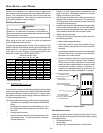
16
E
LECTRICAL
C
ONNECTIONS
For sizing of flexible liners, see Note 22 and the tables in the
National Fuel Gas Code NFPA 54/ANSI Z223.1 - latest edition
and in the National Standard of Canada, CAN/CSA B149.1 and
CAN/CSA B149.2 - latest editions and amendments.
To install the liner, read and follow the liner manufacturer’s in-
structions and your local codes. Excess liner length should be
pulled out of the chimney and cut off. Use caution when doing
this, as the cut edges of flexible liners may be sharp. Do not
spiral excess liner inside of the chimney. Support the liner as
recommended by the liner manufacturer.
Some manufacturers of flexible liners offer an insulation sleeve
designed to be added to the liner before it is installed in the
chimney. (Poured insulation, either vermiculite or other materi-
als, is no longer recommended.) Insulation will need to be added
to the flexible liner if:
• It is required by the liner manufacturer’s instructions.
• The previous liner was properly sized and installed,
and suffered from condensation damage.
• It is required by your local building codes.
Even if none of those three conditions exist which require addi-
tional liner insulation, the installer may wish to consider it if:
• The local climate is very cold.
• The chimney is very tall.
• The vent connectors used are very long or have a large
number of elbows.
• Local experience indicates that flexible liners installed
without insulation are likely to have condensation
problems.
Insulation must be selected and installed in accordance with
the liner manufacturer’s instructions.
Finally, cap the chimney and terminate the liner in accordance
with the liner manufacturer’s instructions.
E
LECTRICAL
C
ONNECTIONS
HIGHVOL TAGE!
T
O
AVOID
THE
RISK
OF
ELECT RICAL
SHOCK
,
WIRING
TO
THE
UNIT
MUST
BE
POLARIZED
AND
GROUNDED
.
WARNING
HIGHVOL TAGE!
T
O
AVOID
PERSONAL
INJURY
OR
DEATH
DUE
TO
ELECT RICAL
SHOCK
,
DISCONNECT
ELECT RICAL
POWER
BEFORE
SERVICING
OR
CHANGING
ANY
ELECT RICAL
WIRING
.
WARNING
L
ABEL
ALL
WIRES
PRIOR
TO
DISCONNECTION
WHEN
SERVICING
CONTROLS
.W
IRING
ERRORS
CAN
CAUSE
IMPROPER
AND
DANGEROUS
OPERATION
.V
ERIFY
PROPER
OPERATION
AFTER
SERVICING
.
CAUTION
HIGHVOL TAGE!
T
O
AVOID
THE
RISK
OF
INJURY
,
ELECT RICAL
SHOCK
OR
DEATH
,
THE
FURNACE
MUST
BE
ELECT RICALLY
GROUNDED
IN
ACCORDANCE
WITH
LOCAL
CODES
OR
IN
THEIR
ABSENCE
,
WITH
THE
LATEST
EDITION
OF
THE
N
ATIONAL
E
LECTRIC
C
ODE
.
WARNING
WIRING H ARNESS
The wiring harness is an integral part of this furnace. Field
alteration to comply with electrical codes should not be re-
quired. Wires are color coded for identification purposes. Re-
fer to the wiring diagram for wire routings. If any of the original
wire as supplied with the furnace must be replaced, it must be
replaced with wiring material having a temperature rating of at
least 105° C. Any replacement wiring must be a copper con-
ductor.
115 VOLT L INE C ONNECTIONS
Before proceeding with electrical connections, ensure that the
supply voltage, frequency, and phase correspond to that speci-
fied on the unit rating plate. Power supply to the furnace must
be NEC Class 1, and must comply with all applicable codes.
The furnace must be electrically grounded in accordance with
local codes or, in their absence, with the latest edition of The
National Electric Code, ANSI NFPA 70 and/or The Canadian
Electric Code CSA C22.1.
Use a separate fused branch electrical circuit containing prop-
erly sized wire, and fuse or circuit breaker. The fuse or circuit
breaker must be sized in accordance with the maximum over-
current protection specified on the unit rating plate. An electri-
cal disconnect must be provided at the furnace location.
Line voltage wiring must enter into the junction box provided
with the furnace.
NOTE: Line polarity must be observed when making field
connections.
FOSSIL F UEL A PPLICATIONS
This furnace can be used in conjunction with a heat pump in a
fossil fuel application. A fossil fuel application refers to a com-
bined gas furnace and heat pump installation which uses an
outdoor temperature sensor to determine the most cost effi-
cient means of heating (heat pump, gas furnace, or both).


















